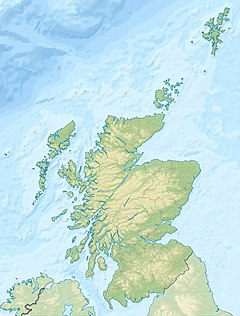Baosbheinn
| Baosbheinn | |
|---|---|

Seen from Beinn Alligin, four km to the south.
|
|
| Highest point | |
| Elevation | 875 m (2,871 ft) |
| Prominence | 443 m (1,453 ft) |
| Listing | Corbett, Marilyn |
| Coordinates | 57°37′40″N 5°33′59″W / 57.6278°N 5.5665°WCoordinates: 57°37′40″N 5°33′59″W / 57.6278°N 5.5665°W |
| Naming | |
| Translation | Various (see text) |
| Pronunciation | Boe-shvyn |
| Geography | |
|
|
|
| Parent range | Northwest Highlands |
| OS grid | NG870654 |
| Topo map | OS Landranger 19, OS Explorer 433 |
Baosbheinn is a Scottish mountain situated in the Torridon area of the Northwest Highlands. It stands in a remote area within the Flowerdale deer forest some 39 km NNE of Kyle of Lochalsh.
Baosbheinn which is made up of Torridon Sandstone reaches a height of 875 metres (2,871 feet) making it the 56th highest Corbett and the 277th highest Marilyn. It is a long elongated mountain with a NW-SE orientation, its summit ridge is impressive, barely dropping below the 700 m (2,300 ft) contour in its 3 kilometres (1.9 miles) length. Its SW slopes drops away steeply and rockily towards Loch a’ Ghobhainn while its NE slopes are less precipitous, throwing out a series of spurs which produces three craggy corries. Strong hill walkers can climb Baosbheinn with the adjacent Corbett of Beinn an Eoin which stands across Loch na h-Oidhche and gives a demanding circular walk of 21 km (13 mi) which takes between six and nine hours.
The translation of Baosbheinn from the Scottish Gaelic language is usually given by guidebooks as “Wizard’s hill” this comes from the word baobh but strictly speaking this translates as a hag or bitch. Buidsear or fiosaiche is the usual word for a wizard. Scholars have put forward alternatives, one of these is beidhis-fjall from the Old Norse language which translates as hunting hill, with the Norse fjall later changed to the Gaelic bheinn . Local residents of Wester Ross refer to the hill as “mountain of the face”, this is explained by the fact that when viewed from Gairloch in the morning light, the hill resembles the appearance of a human head. This is supported by older spellings of the name which use derivations of bathais which translates as face or forehead. In conclusion, although the translated name is usually given as Wizard’s Hill, the alternatives of Hill of the Face, Hunting Hill or Hill of the Hag (or Wicked Person) may have stronger supporting evidence.
...
Wikipedia

